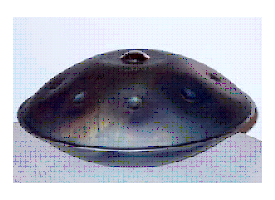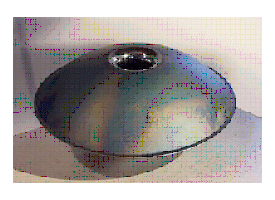


Sound of the Hang
David Wessel, Andrew Morrison, and Thomas Rossing
Wessel: Center for New Music and Audio Technologies, 1750 Arch Street, Berkeley, CA 94720, wessel@cnmat.berkeley.edu
Popular Version of Paper 5aMUf3,
"Sound of the HANG"
Presented 11:40 a.m. on Friday July 4, 2008 at Acoustics '08 Paris
The HANG is a hand-played steel instrument. Since its introduction in 2000, more than 7,000 instruments have been created by PANArt Hangbau AG in Bern, Switzerland. Since it is played with the hands, it is possible to create many different timbres from its notes.
The way in which the note areas vibrate and produce sound and the way in which the sound is radiated have also been described in several papers [3,4]. In this paper, we discuss some playing techniques and the sounds that they produce. We apply these playing techniques to the original HANG as well as to two later instrument designs. We also compare the modes of vibration and sound radiation from the three instruments.
The HANG is shown below. The top (DING) side has 7 to 9 harmonically tuned notes around a central deep note which couples strongly to the cavity resonance of the body. The bottom (GU) side has a large hole which acts as the neck of the cavity resonator. The HANG is usually played horizontally in the lap but it can also be played vertically or on a stand.


The first HANG we tested had nine notes beginning with a centrally located G3 note area. The notes are tuned to a pentatonic scale. Playing the central G3 note excites a strong cavity (Helmholtz) in the body of the instrument. The resonator can be tuned by inserting a DUM into the hole, thus changing its diameter or by varying the spacing of the player’s knees to change the acoustical “length” of the neck. We now refer to this as the “high-voice HANG.”
The low-voice HANG, the second one tested, had ninenotes beginning with a centrally located F3 note area. To satisfy requests for even deeper sounds, the integral HANG was developed by PANArt in 2006. We have recently tested an integral HANG with eight notes beginning with the central D3 note area. The tuning is shown in Figure 4.
To satisfy requests for even deeper sounds, the integral HANG was developed by PANArt in 2006. We have recently tested an integral HANG with eight notes beginning with the central D3 note area. The tuning is shown at the right.

Sound spectra Sound spectra were recorded using a Tekronix FFT analyzer controlled by a laptop computer. Each note area was tapped lightly with a rubber mallet. The spectra for all 8 notes are shown in Figure 9. Each spectrum shows the three principal harmonics, which have frequencies in the ratios 1:2:3. Also visible in each spectrum is a small peak at 85 Hz, the frequency of the cavity resonance (near F2).
Playing techniques
The manner in which the HANG is played has considerable influence on the quality of the sounds that it produces. Playing more or less intensely influences the spectral content, the decay time, and additional features of the amplitude envelope.
When playingfff not only is the overall amplitude dramatically changed but the loud note rings longer than the soft one. The soft note has but two audibly significant components in an octave relationship whereas the intense notes higher frequency components are inharmonic with respect to the fundamental. In addition, the intense note shows significant amplitude modulations due to beating.
An important set of playing techniques involves playing a HANG note with a rapid succession of impacts. This can be accomplished in a variety of ways, the most elementary of which involves playing single stroke roles with the fingers of alternating hands. As each stroke arrives it finds the HANG in a different state. As a result, each of the notes in the roll has a slightly different timbre. This timbral variation provides a quality to the sound that cannot be achieved by repeating the same sample of a HANG to simulate a roll. To demonstrate this effect we modeled the HANG with filters centered at each of the frequency components. The gains and decay times for these resonate filters were estimated from the analysis. We demonstrate the difference in sound quality by comparing the free running set of resonate filters with a version of the model where the state of the filters remains constant at each impulse.
Another effective way to play a rapid succession of single notes is to use a technique analogous to the way a percussionist using sticks plays a flam. This can be accomplished by placing the middle finger just ahead of the index finger when striking the HANG. The arrival times of the two fingers can be controlled by how far they are spaced apart prior to the impact. A variety of timbres can be obtained by controlling the finger spacing in this manner. More complex effects, such as a flurry of notes, can be obtained by arranging the fingers so that the baby finger strikes first followed by the ring, middle, and index fingers in rapid succession.
The HANG's center note with its outwardly extending boss invites a variety of techniques including striking it with a larger surface of hand as with flattened fingers or the base of the palm.
One of the most important aspects of HANG technique is how long the finger or hand remains in contact with the instrument during the stroke. The longer the contact time the greater the damping effect. Many beginning players have difficulty striking the instrument and pulling away quickly making it hard for them to produce notes that ring. One tip is to actually practice making the up stroke rapid separately from the down stoke and then combining them to effectively control the contact time with the instrument.
The HANG can be modeled with filters centered at each of the frequency components; the gains and decay times for these resonant filters can be estimated from the analysis of multiple playing strokes. From the analysis it is possible to synthesize realistic sounds of the HANG. This is the known synthesis of this interesting and popular instrument.
LISTEN: synthesized sound of the HANG
References:
Rossing, T.D., Hansen, U.J., Rohner, F., and Schärer, S. (2001) “The HANG: A Hand-Played Steel Drum,” 142nd ASA meeting, December 2001.
Rohner, F. and Schärer, S. (2007) “History and development of the HANG”, Proceedings of ISMA 2007, Barcelona.
Morrison, A. (2006) Acoustical Studies of the Steelpan and HANG: Phase-Sensitive Holography and Sound Intensity Measurements (PhD dissertation, Northern Illinois University, DeKalb, Illinois)
Rossing, T.D., A. Morrison, U. Hansen, F. Rohner, and S. Schärer (2007) “Acoustics of the HANG: A hand-played steel instrument,” Proceedings of ISMA 2007, Barcelona.